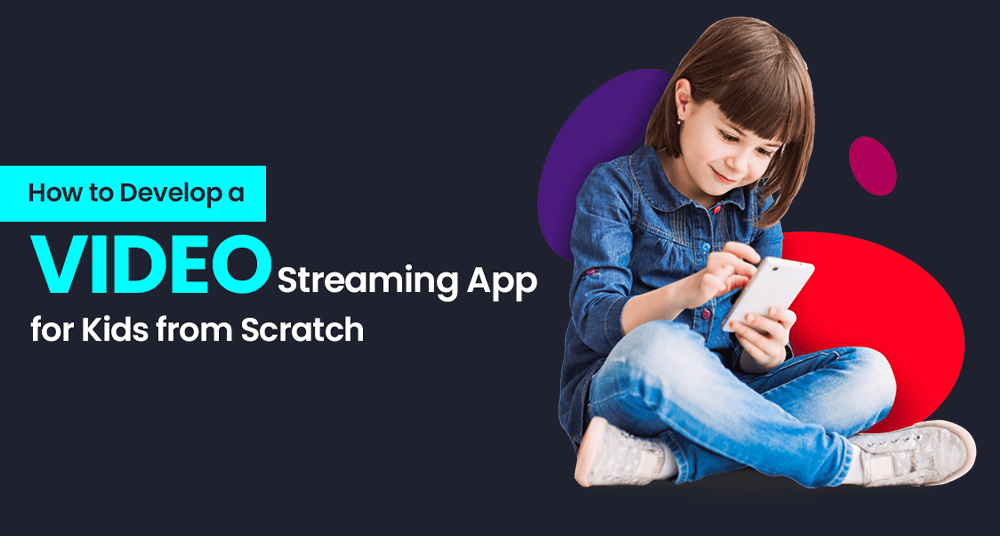Children today are growing up in a digital-first world. Smartphones and tablets have become central to how kids learn, entertain, and explore. According to recent studies, children spend an average of 2–3 hours per day watching videos online, making kids video streaming apps a growing necessity. Parents are increasingly seeking safe, educational, and entertaining platforms that ensure children are not exposed to inappropriate content.
Apps like YouTube Kids have set the benchmark by offering a curated video experience with parental controls, age-appropriate content, and a child-friendly interface. This guide explores how to create a safe video streaming app for kids, focusing on features, technology, monetization, and compliance.
Why Build a Kids Video Streaming App?
The need for safe video streaming apps is growing due to several factors:
Rising Screen Time Among Children
With the increasing availability of smartphones and tablets, children are spending more time watching online videos. Parents want apps that provide safe content, ensuring that children are not exposed to violence, adult content, or inappropriate language.
Growing Parental Concerns
A survey found that 70% of parents are concerned about the content their children access online. There is a demand for apps that provide parental control features, including activity tracking, content approval, and screen time limits.
Business Opportunities
The kids’ streaming market is rapidly growing. Reports suggest that the global kids’ digital content market will surpass $10 billion by 2027. Entrepreneurs can monetize through subscription plans, in-app purchases, branded content, and freemium models.
Core Features of a Safe Kids Video Streaming App
Creating a successful and secure streaming app requires integrating key features that enhance safety, engagement, and usability.
1. Child-Safe Content Filtering
Content filtering ensures children only access appropriate videos.
Implementation:
- AI-Based Moderation: Automatically detect and remove unsuitable videos.
- Manual Curation: Trusted creators and verified content sources.
- Age-Based Categorization: Separate content for toddlers (2–5), younger kids (6–8), and pre-teens (9–12).
2. Parental Control Dashboard
A parental dashboard is essential for monitoring and managing children’s activities:
- Screen time limits.
- Approve or block videos or channels.
- Monitor viewing history.
- Password-protected settings to prevent unauthorized access.
3. Kid-Friendly User Interface
The app’s UI must be simple, colorful, and interactive:
- Large buttons, minimal text, and visual instructions.
- Bright colors and animations to keep kids engaged.
- Gamified experiences like quizzes and challenges for learning reinforcement.
4. Secure User Profiles
Separate profiles for each child enhance security and customization:
- Login through a parent account.
- Encrypted storage of personal information.
- Age verification to ensure proper content filtering.
5. Smart Content Discovery
AI-powered recommendations help children find videos suitable for their age and interests:
- Personalized suggestions based on watch history.
- Categorized content for educational videos, entertainment, music, and DIY activities.
- Safe and engaging recommendations for long-term engagement.
6. Offline Video Access
Downloading videos for offline viewing is essential:
- Provides access during low or no internet connectivity.
- Saves mobile data.
- Maintains age-appropriate content through filtering.
Technology Stack for a Kids Video Streaming App
Choosing the right technology stack ensures scalability, security, and performance.
Frontend Development
- Flutter or React Native for cross-platform apps.
- Responsive designs for tablets and smartphones.
Backend Development
- Node.js, Django, or Firebase for content and user management.
- Integration with streaming services like AWS Media Services, Cloudflare Stream, or Wowza.
Database and Storage
- MongoDB or PostgreSQL for storing user profiles and video metadata.
- Cloud storage with secure access control and encryption.
Security Features
- SSL encryption for data in transit.
- OAuth 2.0 authentication.
- Parental control APIs for filtering and access restrictions.
Step-by-Step Development Process
Market Research
- Study competitors like YouTube Kids, Kidoodle TV, Kideo.
- Analyze gaps in features, content, and usability.
- Conduct surveys or interviews with parents to understand expectations.
Define Features & Monetization
Choose monetization options:
- Subscription Model: Paid premium, ad-free access.
- Freemium Model: Free basic content, optional paid premium content.
- Ad-Supported: Child-safe ads only.
UI/UX Design
- Collaborate with child psychologists for age-appropriate design.
- Bright, colorful interfaces with simple navigation.
- Gamified elements for educational engagement.
Development
- Simultaneously build frontend and backend.
- Implement AI-based content filtering and recommendations.
- Integrate streaming services for smooth video delivery.
Testing & Quality Assurance
- Beta testing with parent supervision.
- Test parental controls, content filters, and offline video functionality.
- Check cross-device compatibility and app performance.
Launch & Marketing
- Release on Google Play Store and Apple App Store.
- Promote through parenting forums, blogs, social media, and influencer marketing.
- Highlight child safety, educational content, and parental controls.
Monetization Strategies for Kids Video Streaming Apps
Even a child-focused platform can generate revenue while maintaining safety and engagement.
Subscription Model
- Offer monthly or yearly subscription plans.
- Benefits: ad-free experience, premium educational content, offline video access.
- Example: YouTube Kids Premium offers additional content and removes ads for subscribers.
Freemium Model
- Provide free access to basic content while offering premium features for a fee.
- Premium features can include:
- Special educational videos.
- Interactive challenges and quizzes.
- Advanced parental control features.
Brand Partnerships and Sponsorships
- Collaborate with educational brands, toy companies, or children’s book publishers.
- Sponsored content should be strictly child-appropriate.
- Example: Short, branded learning videos or interactive tutorials.
In-App Purchases and Rewards
- Offer in-app games, rewards, or badges linked to video learning activities.
- Encourage educational engagement through gamification.
- Maintain child safety by ensuring purchases are parent-approved.
Legal Compliance and Regulations
Creating a kids’ streaming app requires adherence to strict laws and regulations to protect children online.
COPPA (Children’s Online Privacy Protection Act) – USA
- Protects personal information of children under 13.
- Requires parental consent before collecting personal data.
- Examples: Profile creation, email collection, or tracking viewing history.
GDPR-K (Europe)
- Protects children under 16 in EU countries.
- Mandates clear privacy policies, explicit consent, and secure data storage.
Privacy Policies
- Clearly outline what data is collected, how it’s used, and how it’s stored.
- Explain parental rights and content moderation procedures.
Copyright and Licensing
- Use legally licensed videos to avoid infringement.
- For educational videos, consider Creative Commons or direct agreements with creators.
Best Practices for Kids Video Streaming Apps
- Regular Content Moderation: Continuously review videos to maintain safety.
- Child-Friendly Ads Only: Avoid adult-targeted advertising or aggressive pop-ups.
- Parent Feedback System: Allow parents to report inappropriate content.
- Educational & Interactive Content: Combine learning with entertainment for engagement.
- Frequent App Updates: Maintain security, improve features, and refresh content library.
Additional Features to Enhance Engagement
Multi-Language Support
- Cater to children globally by providing content in multiple languages.
- Examples: English, Spanish, Hindi, French.
- Improves reach and usability across regions.
Augmented Reality (AR) Learning
- Interactive AR videos for learning concepts like math, science, or geography.
- Engages children actively and promotes retention.
Integration with Educational Platforms
- Collaborate with e-learning platforms for certified content.
- Include video tutorials, interactive lessons, or storytelling sessions.
Gamification
- Reward systems like points, badges, or levels for watching educational videos.
- Motivates children to learn and interact positively with the app.
Safe Community Features
- Enable child-friendly comments or reactions monitored by AI moderation.
- Include chat or group features for collaboration in educational challenges, if needed.
Emerging Trends in Kids Video Streaming Apps
AI-Powered Recommendations – Personalized content suggestions to maintain engagement safely.
Interactive & Gamified Learning – Learning through quizzes, challenges, and interactive video features.
Globalization – multi-language support to target a worldwide audience.
AR and VR Experiences – Advanced technology for immersive educational content.
Parental Dashboard Enhancements – Advanced analytics and reporting tools for parents to track learning and screen time.
Growth Strategies for Your Kids Streaming App
Targeted Marketing
- Focus on parenting communities, schools, and educational blogs.
- Use social media campaigns highlighting safety and educational benefits.
Partnerships
- Collaborate with educational content creators, publishers, and schools.
- Sponsored content with trusted brands can increase credibility.
Regular Content Updates
- Introduce new videos weekly to maintain interest.
- Seasonal or thematic content can attract new users.
Community Engagement
Involve parents in feedback surveys.
Encourage children to participate in safe, interactive challenges.
Performance Optimization
- Ensure smooth streaming even on low-bandwidth connections.
- Regularly update backend infrastructure to support scalability.
Key Takeaways
- Building a safe video streaming app for kids requires focus on child safety, parental controls, engaging content, and secure technology.
- Features like AI content filtering, offline downloads, multi-language support, and gamification enhance user engagement.
- Monetization strategies include subscriptions, freemium content, branded partnerships, and in-app purchases.
- Legal compliance with COPPA, GDPR-K, and copyright laws is mandatory.
- Continuous content updates, parental engagement, and advanced technology integration ensure long-term success.
By following these strategies, you can create a trusted, educational, and entertaining video streaming app for children, offering parents peace of mind and children a safe digital experience.
Related Blog: Best Indoor Games for Kids






What do you think?
It is nice to know your opinion. Leave a comment.